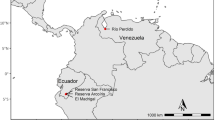Abstract
The relationship between body length and biomass (dry weight) was investigated for nineteen taxa of terres trail arthropods and for the combined sample that included all insect taxa. The specimens were collected from forests of Bicholim taluk of Goa. Four models were evaluated, a linear function, a logarithmic function, a power function and an exponential function. The linear function best describes dry weights in the order Isopoda of class Crustacea and dictyopteran, coleopteran larvae of class Insecta. The logarithmic function fits well for only one group namely Opiliones of class Arachnida. The power functions fits best for Scutigeromorpha and Scolopendromorpha of class Chilopoda, Araneae of class Arachnida, Collembola, Thysanura, Orthoptera, Hemiptera, Homoptera, coleopteran adults, Diptera, lepidopteran adults and Hymenoptera of class Insecta and the combined data on adult insects. An exponential function fits well for the dermapteran and lepidopteran larvae of class Insecta. The usefulness of these estimates of Arthropod biomass in community ecology is discussed.
Similar content being viewed by others
References
Basset Y and Arthington A H 1992 The arthropod community of an Australian rain forest tree: Abundance of component taxa, species richness and guild structure;Aust. J. Ecol. 17 89–98
Borror D J, Delong D M and Triplehorn C A 1981An introduction to the study of insects (New York: Saunders College Publishing)
Draper N R and Smith H 1981Applied Regression Analysis 2 edition (New York: John Wiley)
Ganihar S R 1990Impact of mining on thefaunal composition ofGoa, Ph. D Thesis, Goa University, Goa
Gowing G and Recher H F 1985 Further comments on Length-Weight relationships of invertebrates;Aust. J. Ecol.10 195
Jangi B S 1966Scolopendra 9 The Indian zoological Memoirs on Indian Animal Types (ZSI Publication)
Lefroy H M and Howlett F W 1971Indian insect life (New Delhi: Indian Agricultural Research Institute, Today and Tommorrow Printers and Publishers)
Mani M S 1972General entomology (New Delhi: Oxford and IBH)
Mani M S 1974Modern classification of insects (Agra: Satish Book Publishers)
Rogers L E, Hinds W T and Buschbom R L1976 A general weight versus length relationship for Insects;Ann. Entomol. Soc, Am. 69 387–389
Rogers L E, Buschbom R L and Watson C R 1977 Length-Weight relationships of Shrub-Steppe Invertebrates;Ann. Entomol. Soc. Am. 70 51–53
Sage R D 1982 Wet and Dry-weight estimates of Insects and spiders based on length;Am. Midi. Nat. 108 407–411
Schoener T W 1980 Length-Weight regressions in tropical and temperate forest-understory insects;Ann. Entomol. Soc. Am. 73 106–109
Tikader B K 1987Handbook ofindian spiders (ZSI Publication)
Author information
Authors and Affiliations
Rights and permissions
About this article
Cite this article
Ganihar, S.R. Biomass estimates of terrestrial arthropods based on body length. J. Biosci. 22, 219–224 (1997). https://doi.org/10.1007/BF02704734
Received:
Revised:
Published:
Issue Date:
DOI: https://doi.org/10.1007/BF02704734




